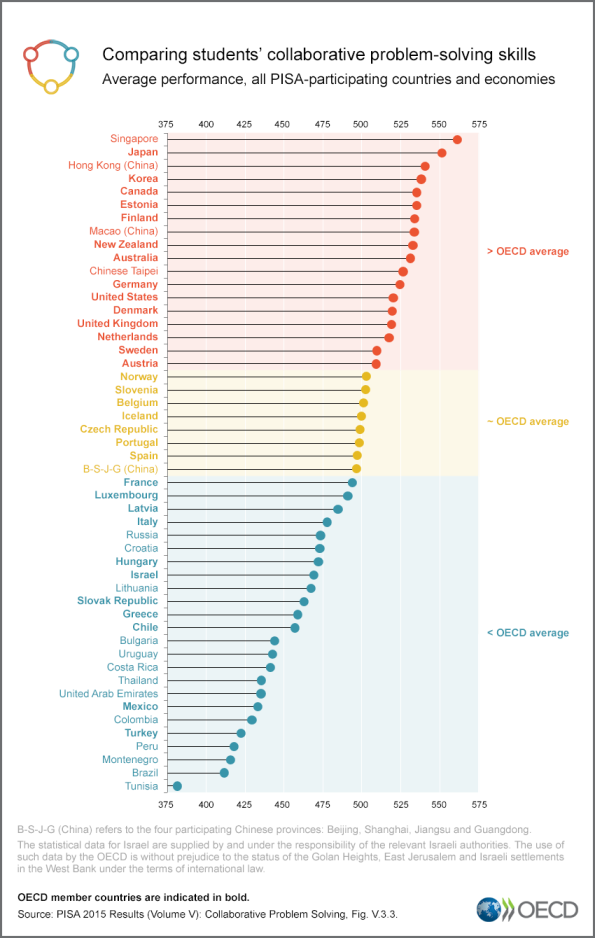Education

PISA 2015 Results (Volume V)
Collaborative Problem Solving
Published on November 21, 2017Also available in: French
In series:PISAview more titles
SUMMARIESavailable in 26 languages
| English | PISA 2015 Results (Volume V) (Summary in English) | |
| French | Résultats du PISA 2015 (Volume V) | |
| Spanish | Resultados de PISA 2015 (Volumen V) | |
| German | Ergebnisse von PISA 2015 (Band V) | |
| Japanese | 2015年OECD生徒の学習到達度調査(PISA 2015)(第5回)の調査結果 | |
| Italian | Risultati PISA 2015 (Volume V) | |
| Chinese | 2015年国际学生评估项目结果(第五卷) | |
| Czech | Výsledky hodnocení PISA za rok 2015 (díl V) | |
| Danish | PISA 2015-resultater (Bind V) | |
| Dutch | PISA 2015 Resultaten (Volume V) | |
| Estonian | 2015. aasta PISA uuringu tulemused (osa V) | |
| Finnish | PISA 2015 Tulokset (V Osa) | |
| Greek | PISA 2015 Αποτελέσματα (Τόμος V) | |
| Hebrew | תוצאות מבחני פיז"ה לשנת 2015 (כרך 5) | |
| Hungarian | 2015. évi PISA-eredmények (V. kötet) | |
| Icelandic | Niðurstöður PISA 2015 (V. bindi) | |
| Korean | 2015년 국제학생평가프로그램 결과 (제5권) | |
| Latvian | PISA (Starptautiskā skolēnu novērtēšanas programma ) 2015. gada rezultāti (V sējums) | |
| Norwegian | Resultater fra PISA 2015 (volum V) | |
| Polish | Wyniki badania PISA 2015 (Część V) | |
| Portuguese | Resultados PISA 2015 (Volume V) | |
| Russian | Результаты PISA 2015 (Том V) | |
| Slovak | Výsledky prieskumu PISA z roku 2015 (zväzok V) | |
| Slovene | Rezultati PISA 2015 (Letnik 5) | |
| Swedish | PISA 2015 Results (Volume V) | |
| Turkish | 2015 PISA Sonuçları (V. Bölüm) |
TABLE OF CONTENTS
| Foreword | |
| Editorial | |
| Executive summary | |
| Reader's guide | |
| What is PISA? | |
| Overview: Collaborative problem solving | |
| What is collaborative problem solving? | |
| Performance in collaborative problem solving | |
| Student demographics and performance in collaborative problem solving | |
| Students' attitudes towards collaboration | |
| Student activities, school practices and collaboration | |
| Collaborative schools, collaborative students | |
| What the PISA 2015 results on collaborative problem solving imply for policy | |
|
See also "Girls outperform boys in collaborative problem solving" Data SAS (TM) Data Files (compressed) - Collaborative Problem Solving (41MB) SPSS (TM) Data Files (compressed) - Collaborative Problem Solving (33MB) |
Newsroom Blog Are school systems ready to develop students’ social skills? Country notes France (French) (English) Countries and economies who participated In total 52 countries and economies participated in the 2015 assessment of collaborative problem solving. OECD countries: Australia, Austria, Belgium, Canada, Chile, the Czech Republic, Denmark, Estonia, Finland, France, Germany, Greece, Hungary, Iceland, Israel, Italy, Japan, Korea, Latvia, Luxembourg, Mexico, the Netherlands, New Zealand, Norway, Portugal, the Slovak Republic, Slovenia, Spain, Sweden, Turkey, the United Kingdom and the United States. Partner countries and economies: Beijing-Shanghai-Jiangsu-Guangdong (China), Brazil, Bulgaria, Colombia, Costa Rica, Croatia, Cyprus*, Hong Kong (China), Lithuania, Macao (China), Malaysia**, Montenegro, Peru, the Russian Federation, Singapore, Chinese Taipei, Thailand, Tunisia, the United Arab Emirates and Uruguay. *Note by Turkey: The information in this document with reference to « Cyprus » relates to the southern part of the Island. There is no single authority representing both Turkish and Greek Cypriot people on the Island. Turkey recognises the Turkish Republic of Northern Cyprus (TRNC). Until a lasting and equitable solution is found within the context of the United Nations, Turkey shall preserve its position concerning the “Cyprus issue”.
|
|
Archived webinar
|
PowerPoint |
TopClass Podcast - What collaborative problem solving can tell us about students' social skills
|
